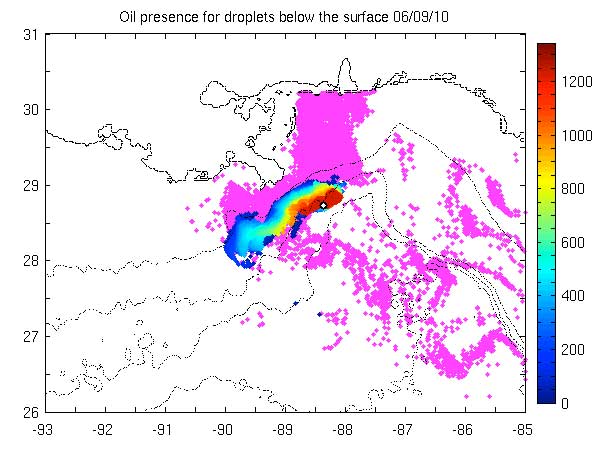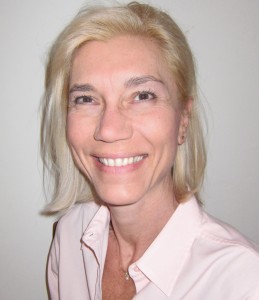Numerical study suggests that subsea injection of oil-dispersing chemical at Macondo well did not prevent oil from rising to the surface
|
|
By This email address is being protected from spambots. You need JavaScript enabled to view it., University of Miami Rosentiel School of Marine and Atmospheric Science
MIAMI — December 4, 2012 - The 2010 blowout of the Macondo well in the waters of the Gulf of Mexico resulted in the region’s largest oil spill in U.S. history. As the Deepwater Horizon (DWH) incident unfolded, in an effort to prevent the oil from coming to the surface and reaching coastal and marsh ecosystems, chemical dispersants were injected at the wellhead. These powerful dispersants, typically used to break up oil slicks at the sea surface had never been used in such large quantities and over such a prolonged period of time in the deep ocean.
A new study published in Environmental Science & Technology, led by University of Miami (UM) Rosenstiel School of Marine & Atmospheric Science Associate Professor of Applied Marine Physics Claire Paris, is the first to examine the effects of the use of unprecedented quantities of synthetic dispersants on the distribution of an oil mass in the water column, based on a modeling approach. The team of researchers included UM Rosenstiel School Assistant Scientist Matthieu Le Henaff and Research Associate Professor Villy Kourafalou, UM Center for Computational Science (CCS) Scientist Judith Helgers and Research Associate Professor Ashwanth Srinivasan, Ph.D. Candidate Zachary Aman from Colorado School of Mines, Research Associate Professor Ajit Subramaniam from Lamont Doherty Earth Observatory at Columbia University, and Professor Dong-Ping Wang from the School of Marine and Atmospheric Science of SUNY at Stony Brook. Together they developed and tested models to show that the application of oil-dispersing chemicals had little effect on the oil surfacing in the Gulf of Mexico.
“Deepwater drilling into large, high-pressure reservoirs of oil and gas located far offshore and hundreds of meters below the ocean’s surface involves risks for which we were not adequately prepared,” said Paris. “As the oil gushed uncontrolled into the Gulf, injection of chemical dispersant into the deep ocean may have had little effect because the oil was coming out with such pressure that it was already dispersed in small droplets. It is impossible to know whether the synthetic dispersant was well mixed with the oil as it was injected. Our models treat both scenarios, and regardless of whether you have the dispersant in the water mixture or not, the amount of oil reaching the sea surface remained relatively unchanged.”
The researchers estimated the distribution of oil droplet sizes with and without injection of dispersant at the wellhead. They then applied a novel oil-mass tracking model of the Connectivity Modeling System (CMS) developed shortly after the DWH incident with a RAPID award from the National Science Foundation (NSF) and presented a three-dimensional simulation of the DWH spill showing the unfolding of the disaster to examine the effect the synthetic dispersant may have had on the oil transport in the water column. The model indicated that the dispersant injected at BP's Macondo wellhead was not necessary to break up the oil. The subsea application of dispersant did not have its expected outcome.

“This study is notable because it presents a comprehensive estimate of the Macondo blowout from the microscopic oil-water interface through the macroscopic transport of crude oil.” said chemical engineer Aman.
The work served as a milestone in assessing the three dimensional transport of oil in the water column. “Since the beginning of the spill our model accurately predicted the decoupling between the surface and subsea oil transport, and was unique in showing the southwest extension of the deep plume,” said physical oceanographer Le Henaff. “Correct assessment of upwelling and downwelling currents for the circulation model created a realistic scenario that we then used to test the effect of the injection of dispersant on the oil partition.”
As global deep-sea oil exploration expands, the model will be helpful in quantifying the utility of synthetic dispersants for deep water oil leaks. “The CMS oil model was able to predict the strange layering of oxygen deficit anomalies that we observed during our field sampling and provided us a three dimension view of a phenomena that was constantly changing in time. For us, it was like being able to track the ghosts of the oil plume because the oil itself had been consumed by the microbes and all that was left were the oxygen anomalies and the model was critical for us to understand what we were observing in the field,” said biological oceanographer Subramaniam.
These findings expand on a previous study published earlier this year in which the team studied the crucial role of wind-induced surface drift on the fate of the oil in the Gulf of Mexico. “This current study reveals unexplored pathways of the oil transport by underwater currents and highlights the importance of topographic interactions and vertical flows in moving the deep plume toward deep waters or up the water column.” said physical oceanographer Wang.
This study was supported by the NSF-RAPID OCE 1048697 award to C. Paris. The contribution of Paris and Kourafalou were also made possible in part by grants from The Gulf of Mexico Research Initiative, to the Center for Integrated Modeling and analysis of the Gulf Ecosystem (C-IMAGE) and the Deep Sea to Coast Connectivity in the Eastern Gulf of Mexico (DEEP-C), respectively. The Metcalf Institute for Marine & Environmental Reporting at the University of Rhode Island Graduate School of Oceanography was essential in bringing a chemical engineer, Zachary Aman, to the team via the NSF-RAPID DRL-10-55381 to Sunshine Menezes.
The CCS has emerged as a leader in providing a robust cyber infrastructure designed to address major computational challenges, and is now recognized among the State’s top academic centers, and is gaining national prominence for its work. Its high performance computer core supports work a variety of fields such as genomics, computational biology, marine ecosystems modeling, climate and meteorology, computational fluid dynamics and social systems informatics. For more information, please visit www.ccs.miami.edu.
The University of Miami’s mission is to educate and nurture students, to create knowledge, and to provide service to our community and beyond. Committed to excellence and proud of the diversity of our University family, we strive to develop future leaders of our nation and the world. Founded in the 1940’s, the Rosenstiel School of Marine & Atmospheric Science has grown into one of the world’s premier marine and atmospheric research institutions. Offering dynamic interdisciplinary academics, the Rosenstiel School is dedicated to helping communities to better understand the planet, participating in the establishment of environmental policies, and aiding in the improvement of society and quality of life. For more information, please visit www.rsmas.miami.edu.
The Deep-C consortium is a long-term, interdisciplinary study investigating the environmental consequences of petroleum hydrocarbon release in the deep Gulf of Mexico on living marine resources and ecosystem health. The consortium focuses on the geomorphologic, hydrologic, and biogeochemical settings that influence the distribution and fate of the oil and dispersants released during the Deepwater Horizon accident, and is using the resulting data for model studies that support improved responses to possible future incidents.
|
|
Dr. Villy Kourafalou is a member of the Deep-C Consortium's Modeling Task Group. Dr. Kourafalou is a Research Associate Professor at UM’s Rosenstiel School of Marine and Atmospheric Science, where she leads the Coastal and Shelf Seas Group in the Division of Meteorology and Physical Oceanography. She is also the co-Director of the Ocean Modeling and Observing System Simulation Experiments joint center with the Atlantic Oceanographic and Meteorological Laboratory of the National Oceanic and Atmospheric Administration (NOAA). Her research focuses on numerical modeling of circulation and transport on continental shelves and marginal seas, including coastal processes influenced by land runoff, weather events and deep sea oceanic currents.
|
|
Dr. Ashwanth Srinivasan is a member of the Deep-C Consortium's Modeling Task Group. His research interests include Numerical modeling and the application of inverse Methods to Oceanic Problems, High performance computing, scientific code development and parallel computing, Bio‐physical modeling and marine population connectivity studies and Oceanography of the Indian Ocean. Dr. Srinivasan’s Consulting and Support Areas are Earth and Eco‐system modeling and data assimilation, Development, optimization and parallelization of large scientific codes and Operational Ocean and Atmospheric modeling, data management and distribution.
Deep-C was a four-year, interdisciplinary study of deep sea to coast connectivity in the northeastern Gulf of Mexico.Deep-C is no longer an active research project. The information on this website is for historical reference purposes only.
Home | About Us | Research Areas | Data Center | News & Multimedia | Education & Outreach
© Deep-C Consortium. All Rights Reserved.
This research was made possible by a grant fromThe Gulf of Mexico Research Initiative (GoMRI).
Copyright | Disclaimer | Privacy Policy

 Screen Capture: June 9, 2010 snapshot of the simulated Deepwater Horizon oil spill -representation of the oil transport reveals the formation of the prominent deep hydrocarbon plume and the layering of shallower plumes. The color-bar represents oil particle depth in meters, where red particles are below 1000 m. Particles reaching the upper 20 m of the water column are shown in magenta (pink) and depict the transport of oil at the surface. The decoupling of the deep and sub-surface oil transport is evident.
Screen Capture: June 9, 2010 snapshot of the simulated Deepwater Horizon oil spill -representation of the oil transport reveals the formation of the prominent deep hydrocarbon plume and the layering of shallower plumes. The color-bar represents oil particle depth in meters, where red particles are below 1000 m. Particles reaching the upper 20 m of the water column are shown in magenta (pink) and depict the transport of oil at the surface. The decoupling of the deep and sub-surface oil transport is evident.
